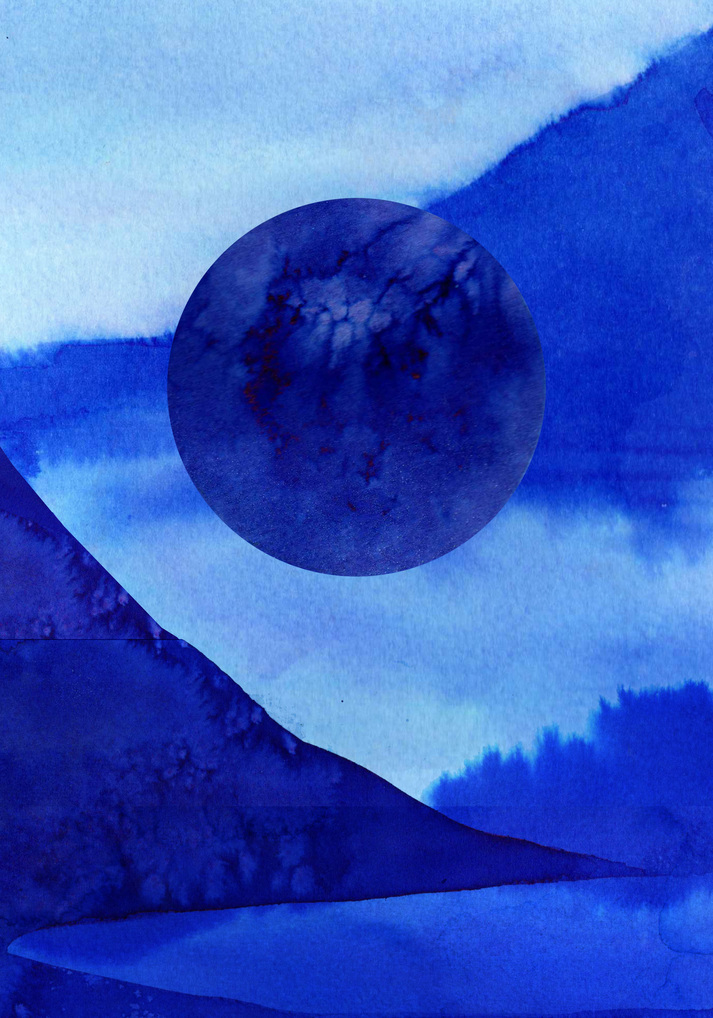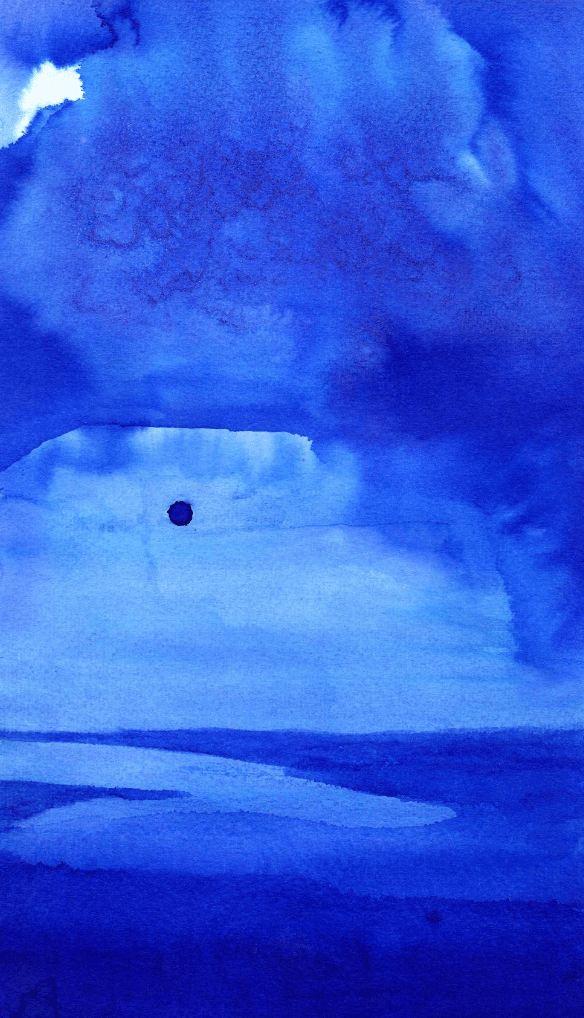Rita Louis
Lost Landscapes – Between Memory and Medium
Rita Louis is a multi-disciplinary artist whose work traverses the delicate boundaries between memory and place. Her series ‘Lost Landscapes’ emerges from a deeply personal narrative of displacement, creating visual poems that speak to both individual and collective experiences of belonging.
Working primarily with Indian ink, watercolor, and salt, Louis creates abstract landscapes that hover between recognition and dissolution. Her technique is particularly noteworthy in its innovative use of salt as both medium and metaphor – a substance that, like memory itself, both preserves and erodes. The resulting works exist in a liminal space, where landscapes are simultaneously forming and fading, much like the ephemeral nature of remembered spaces.
In pieces such as ‘Buried Sky’ and ‘Blue Moon,’ Louis demonstrates a sophisticated understanding of how medium can embody meaning. Her predominant use of blue creates a unifying visual language throughout the series, suggesting both water and sky, depth and infinity. The works are characterized by their nebulous qualities, where forms emerge and recede in a constant state of flux, mirroring the artist’s exploration of fragmentary memories and shifting identities.
Louis’s artistic process is highly intuitive, yet reveals a calculated understanding of material behavior. Her manipulation of water-based mediums creates compositions that appear both controlled and spontaneous. The layering technique she employs builds depth while maintaining transparency, allowing viewers to perceive multiple dimensions within each piece – much like the layered nature of memory itself.
What distinguishes Louis’s work is its ability to transform personal narrative into universal experience. While rooted in her own history of movement between Kuwait, India, and the UK, her abstractions operate on a more profound level, where landscape becomes a vehicle for exploring the psychological territory of displacement. The works reveal themselves gradually, much like memories surfacing from the subconscious, rewarding sustained viewing with ever-deeper layers of meaning.
In ‘Lost Landscapes,’ Rita Louis advances contemporary discourse around identity and place-making through works that are both technically accomplished and conceptually rich. Her practice demonstrates how abstract art can communicate complex narratives of displacement while maintaining visual poetry and material innovation. These works invite viewers into spaces that are simultaneously familiar and strange, much like the landscapes of memory themselves.
Priya Jai
Artist & Curator
Priya Jai is a multidisciplinary artist whose work spans painting, sculpture, theater, photography, and fashion design. She pursued her artistic training at the prestigious Viswa Bharathi University in West Bengal, where she studied under renowned artists Vinod Bihari Mukherji and Ramkinkar Baij at Santiniketan.
Her early works, which earned recognition from the Central Lalita Kala Akademi, focused on social themes, particularly exploring the lives of marginalized communities and the complexities of urban poverty. The Santiniketan experience profoundly influenced her artistic philosophy, fostering her belief that art transcends physical spaces.
Priya has exhibited extensively, with notable solo shows at the Jehangir Art Gallery, Nehru Art Gallery (2002), and the Lalitha Kala Akademi in Bangalore (2004). As a curator and project manager, she actively shapes contemporary art discourse through innovative exhibitions and collaborations.
Currently based in Palakkad, Priya continues to expand her artistic horizons through international collaborations while maintaining strong connections to Kerala’s cultural landscape. Her work reflects a deep understanding of regional artistic traditions while engaging with global contemporary art practices.
priyasreelatha1978@gmail.com
 Rita Louis | Blue Moon II
Rita Louis | Blue Moon II
Your work is deeply rooted in the themes of displacement and belonging. How do these personal experiences influence your artistic approach?
My personal experiences with displacement have profoundly shaped my artistic approach. Growing up between different cultures created an early awareness of shifting identities and the subtle differences in how spaces feel.
These experiences manifest in my work through deliberate material juxtapositions—pairing elements that don’t naturally coexist but find harmony either through careful arrangement or the unpredictability of their nature.
You mention that your paintings evoke feelings of nostalgia and solitude. Can you tell us more about how you capture these emotions through your choice of materials and techniques?
The early and ongoing experiences of constantly moving between different places namely Kuwait, India and London profoundly shaped my artistic perspective. These transitions have taught me to see landscapes not just as physical spaces, but as repositories of memory and emotion. I express this fluid sense of place through my choice of materials – Indian ink, watercolor, and salt – which naturally create ethereal, shifting effects. This technique allows me to capture that delicate space where memory meets imagination, where familiar places dissolve and reform, much like my own experience of belonging everywhere and nowhere. The resulting works exist in a dreamlike state between past and present, mirroring how we carry places within us long after we’ve left them.
 Rita Louis | Buried Sky
Rita Louis | Buried Sky
Your use of blue and the layering of watercolour, ink, and salt is quite unique. How did you develop this style, and what does each medium represent in your work?
In my ‘Lost Landscapes’ series, I’ve developed a distinctive process using Indian ink, watercolor, and salt. The watercolor, particularly in the blue palette I favor, creates atmospheric depth that evokes emotional resonance. The Indian ink provides structure and movement, while the salt introduces an element of unpredictability and discovery. Blue holds a special resonance in my work – it speaks to both the universal and the deeply personal. The color evokes the vast expanse of sky and sea, those boundless spaces that connect rather than divide places and memories. When I feel stuck, I often lean into experimenting – watching how the salt interacts with watercolor, allowing their natural behaviors to guide me rather than trying to control every aspect of the piece. There is a lot to be learned through this intuitive process.
In your pieces, you explore the connection between the past and the present. How do you navigate the tension between memory and reality in your artwork?
My material choices deliberately create a tension between control and release that mirrors how we experience place and memory. I work with ink and watercolor, allowing unexpected interactions that reflect how memories evolve and shift over time.The resulting pieces exist in an in-between state – neither purely representational nor completely abstract – which I find truthfully reflects how we hold places in our minds. The recognizable elements anchor the work in reality, while the more abstract qualities capture the emotional and sensory aspects of remembrance.
Through this approach, each painting becomes both a personal meditation on remembered landscapes and an invitation for viewers to access their own spatial memories. I’m particularly interested in that moment when a viewer connects with a piece not because they recognize the specific location, but because they recognize the feeling of remembering.

Leave a Reply